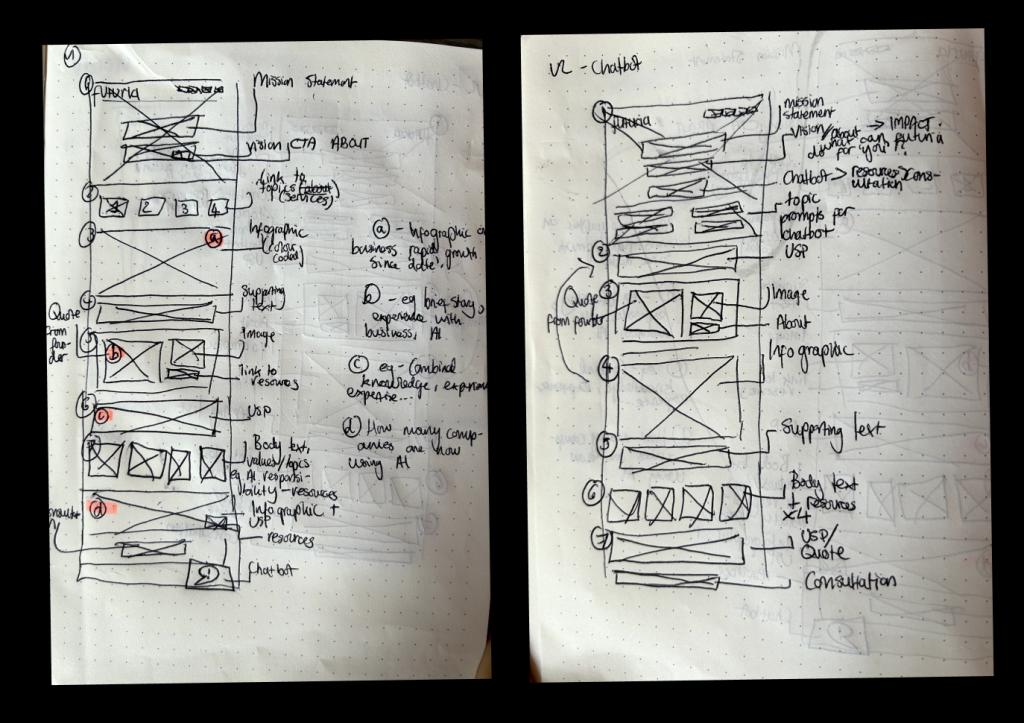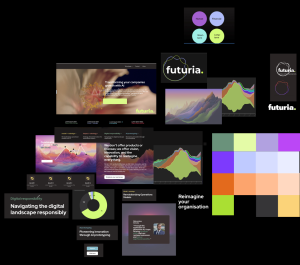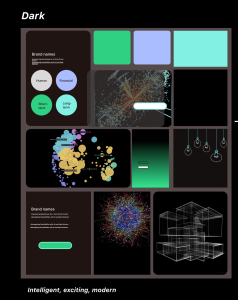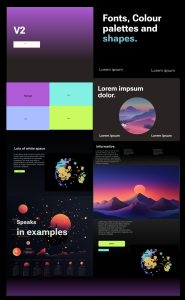Futuria: Crafting a Human-First Brand for an AI Consultancy
I led the branding process for Futuria: a new to the scene SaaS company
specialising in AI-driven solutions.
Project overview:
Futuria, a forward-thinking SaaS company specializing in AI-driven solutions, needed a brand that embodied both cutting-edge innovation and human-centric accessibility. My challenge was to craft a visual and verbal identity that demystifies AI while inspiring trust and excitement for its transformative potential.
Problem
- Tech Overwhelm: Many organisations feel intimidated by rapid technological advancements and how to embrace them
- AI Uncertainty: Concerns about ethical implications and misuse fuel skepticism.
- Resistance to change: established businesses can be afraid of change and how it could impact their current business model.
Solution
The Objective: Create a brand identity that balances innovation with accessibility, simplifying complex AI concepts and addressing audience apprehensions.
The name "Futuria" reflects a fusion of the future and visionary thinking. The name positions the company as a leader in driving transformative change through AI.
The name "Futuria" reflects a fusion of the future and visionary thinking. The name positions the company as a leader in driving transformative change through AI.
- Making AI Approachable → A Friendly and Inviting Brand: The brand must feel inviting, friendly, steering away from traditional corporate style. Brands visuals in a way that simplifies complex AI concepts
- Building Trust Through Design → A Rounded and Reassuring Typeface: I used ‘Poppins’ as the heading font - this is a versatile font characterised by its roundeedness - allowing the soft tone of the font to balance out what may be perceived as intimidating concepts
- Bridging the Gap → Human-Centric Imagery: Deciding on the right imagery to resemble complex technology in a non intimidating way was a big decision. I decided to shift away from using "techy” visuals that often exist in expansive, unrelatable spaces–and focus in on more familiar world instead, one where people exist. This would help businesses visualise the future that Futuria was offering–one where AI and humans thrived.
1.
Identifying the target audience. I segmented potential users by industry, including finance, healthcare, technology, and renewable energy. However, I realised that a more valuable approach was to focus on the unique behaviours and priorities of the C-suite across these sectors.
C-suite executives are key decision-makers who face overlapping challenges, such as limited time, data overload, and pressure to deliver strategic results. Understanding these insights allowed me to humanise insights and guide design decisions.

2.
I grouped the C-Suite audience into four core personas:
This would help me ensure the brand messaging resonated with our target. Since a primary goal of mine was to communicate to this audience, the ways in which they would benefit from the introduction of our AI services–I figured it would make sense to separate groups on where they were positioned on AI, each with an independent hierarchy of needs.
I identified key pain points and designed solutions that aligned with their priorities.
C-suite executives have unique challenges that differ from other roles in the business.
-
1. Limited Time: Executives prefer digestible, visually appealing content due to their time constraints.
Solution → Clear, Concise Content: Futuria’s brand materials prioritised clarity with infographics, reports, surveys, and short videos—ensuring information was easy to scan and impactful. -
2. Measuring Success: Difficulty in assessing business performance against competitors.
Solution → Performance Tracking & Competitive Insights: The brand messaging positioned Futuria as a tool for tracking success, offering comparative analytics and strategic insights to help executives make data-driven decisions. -
3. High-Stakes Decision-Making: Pressure to make the right choices to protect their position and company stability.
Solution → Trust & Proof of Success: Branding emphasised case studies, proven success stories, and long-term impact, showcasing how Futuria enables strategic decision-making.
-
4. Public Image & Transparency: Decisions face media scrutiny and public judgment.
Solution → Ethical AI Approach: Futuria’s brand voice embraced transparency, positioning AI as an ethical, responsible tool that enhances rather than replaces human expertise. -
5. AI Skepticism & Fear of Disruption: Uncertainty about how AI will impact business, often leading to instinct-based decisions.
Solution → Reassurance & Mentorship: The brand identity was designed to be reassuring, friendly, and mentor-like, positioning Futuria as a trusted partner rather than a disruptor.
3.
Light or Dark? Electric Neon or Soft Pastel?
Familiar vs Other Worldly?
...Are decisions that can determine exactly how your new brand will be perceived by an audience.
4.
User Flows to Wireframes
This crucial part of the site-build allows me to design and share the site architecture before design.

User Flows are a method that allows the designer to visualise the priorities of a user whilst navigating through a website. Wireframes allow us to shift these goals onto a tangible web page structure, highlighting CTA's and prioritising content based on these goals.
5.
Product: simple, clean, effective.
-
This brand is built to feel non intimidating, welcoming the audience into a world where AI technology and the world we know today intertwine as one.



